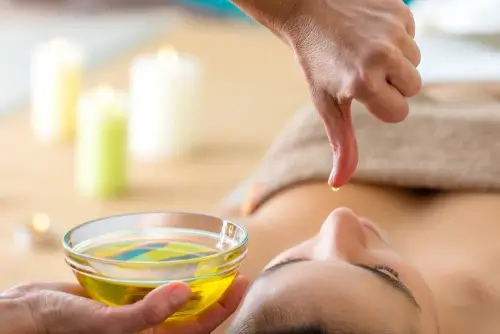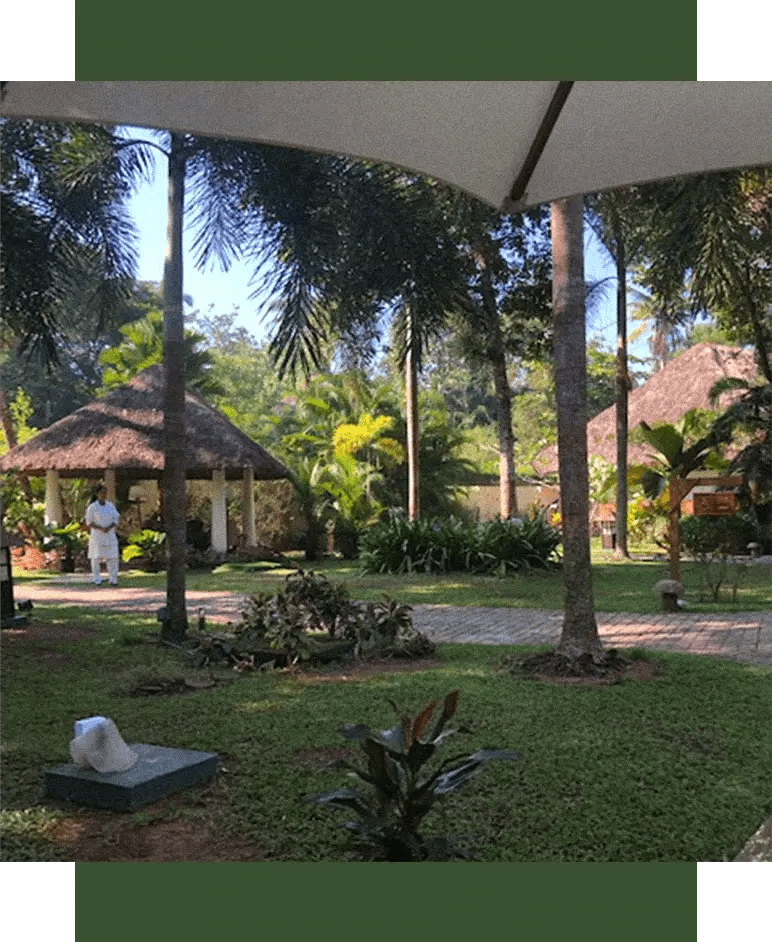Learn about Ayurvedic treatments in India with me. I invite you to Kerala . Did you know that Kerala is a state in southern India that is considered the capital of Ayurveda? For over 60 years, the communist party has been ruling Kerala without a break. Communism there is a bit different from the one we know from history because companies can develop freely and there is private property. However, there are not such great social inequalities as in other states of India. Kerala is also the state in India with the smallest number of illiterates (only 6% of the population), the highest level of health care, a significant number of Christians, huge fields, medicinal plants and promotion of a healthy lifestyle.

Kerala is known for its centres where Ayurvedic treatments are carried out and we went to one of them to learn about their methods and treatments and to actually see what plants are used in them.
WHAT AN AYURVEDIC CENTER LOOKS LIKE
Ayurvedic centers in Kerala are places full of peace, harmony and closeness to nature. They are usually located in the surroundings of tropical vegetation, near a river, lake or on the shores of the Indian Ocean, conducive to deep relaxation and regeneration.
The Ayurvedic center in Kerala that I visited had traditional architecture inspired by the Kerala style, with wooden structures, carved details and tiled roofs. Everyone had their own cottage with spacious interiors, decorated in natural colors, using wood and stone. Around the buildings stretched lush gardens full of coconut palms, banana trees, lotuses and medicinal herbs used in Ayurvedic therapy.
The rooms had large windows to let in fresh air and natural light. My bungalow overlooked the garden. The interior was relaxing, with a bed draped in white, airy curtains and decorations limited to handmade carvings and traditional textiles.
Ayurvedic Therapy Center
The heart of the resort is the Ayurvedic clinic, where guests undergo individual consultations with an experienced Ayurvedic doctor (vaidya). On this basis, treatments, diets and herbal therapies are selected.
As a reminder to blog readers, a short definition of Ayurveda is a system of Indian medicine based on natural principles. It deals with physical, mental and spiritual health. Those who use the principles of Ayurveda are usually vegetarians because one of the principles is not to harm animals.
In the Ayurvedic center where I spent two weeks, it was not allowed to have leather clothing. Leather shoes or handbags are not welcome. Likewise, phones and computers - you can have them, but only in your room. You will not drink alcohol there or smoke a cigarette. Strictly forbidden because it is unhealthy and poisons the body, and the purpose of staying in such a center is complete cleansing. I chose a "light" center, i.e. only with external treatments such as massages, however, the most recommended are centers where panchakarma is practiced. These are "hardcore" cleansing treatments that should last more than 3 weeks to be carried out properly.
Ayurvedic treatments - panchacarma
Panchakarma is a traditional method of deep cleansing of the body used in Ayurveda, which aims to remove toxins and restore the balance between the three energies - doshas (Vata, Pitta, Kapha). It is an intensive detoxification process, which includes both preparation of the body and proper cleansing therapies and a period of regeneration. Panchakarma is not a single procedure, but consists of several stages, which Ayurvedic procedures must be carried out in the right order to be effective and safe.
The first stage is Purvakarma , or preparing the body for deep cleansing. During this time, the patient is given specially selected herbal oils, which are intended to soften the toxins accumulated in the body and facilitate their removal. The key element of this phase is Snehana , or oiling the body, which can be done both internally - by consuming specific amounts of ghee or medicated oils, and externally - in the form of full-body massages (Abhyanga). The next step is Swedana , or Ayurvedic steam treatments, during which the patient is exposed to warm steam with the addition of herbs, which helps open the skin's pores and mobilize toxins for excretion.
Once the body is properly prepared, the actual cleansing, or Pradhanakarma , begins. This stage includes five main cleansing procedures that are tailored to the individual health condition of the patient.
Vamana is an emetic therapy, mainly used in people with excess Kapha dosha to remove excess mucus and toxins from the upper digestive tract.
Virechana involves controlled laxation using natural herbal remedies, which helps cleanse the liver and intestines, especially in people with Pitta disorders.
Basti , or therapeutic enemas with oils and herbal decoctions, are used to cleanse the intestines and restore the balance of the Vata dosha.
Nasya is a therapy for cleansing the sinuses and upper respiratory tract through the application of oils or herbal preparations to the nose, which helps remove accumulated toxins and improves the functioning of the respiratory and nervous systems.
The last procedure is Raktamokshana , or bloodletting therapy, used less frequently and mainly in cases of serious disorders related to excess toxins in the blood.
After intensive cleansing, the body needs regeneration, which is why the last stage is Paschatkarma , or the period of convalescence. During this time, the patient goes on an easily digestible diet, takes herbal strengthening preparations and gradually returns to a normal lifestyle.
The key role here is played by Rasayana , or rejuvenation therapy, which involves the use of special herbs and tonics that strengthen immunity and regenerate the body. Yoga exercises and meditation are also gradually introduced to enhance the effects of Panchakarma and maintain energy balance for longer.
Panchakarma is a demanding but extremely effective cleansing and regeneration process that allows the body to return to its natural harmony. It is not only a therapy for the body, but also for the mind, as it helps release accumulated stress, improves clarity of thought and strengthens vital forces. To achieve the best results, it is recommended to conduct Panchakarma in an authentic Ayurvedic center under the supervision of experienced doctors who will select the appropriate procedures for the individual needs of the patient.
I didn't decide to do such Ayurvedic treatments but I know people who have undergone them and were very satisfied. However, this requires more courage.
As I mentioned earlier, my stay was more of a "sanatorium" stay. In a beautiful Ayurvedic center, the entire stay was carefully planned. The schedule of activities is established with the doctor, who conducts an interview when you check in at the center and determines what treatments are necessary. During the interview, the doctor will typically ask about your well-being, health problems, lifestyle, stress, check your pulse, tongue, and look into your eyes. He will also determine your dosha.
What is a dosha? According to Ayurveda, a human being is made up of five elements: earth, water, fire, air and space. They create three energy forces – doshas called vata, pitta and kapha. These doshas should be in balance. If one predominates, it should be balanced with lifestyle, exercise, diet and ultimately natural medicine. This imbalance causes poor well-being and disease.
After meeting with the doctor, we get a plan, we also know what we can eat because the menu at the center is determined for our dosha. We don't wear our own clothes here. Everyone has their own white loose-fitting outfit, which they can change for a clean one every day if they want.
The day begins early in the morning, at 6:00 with outdoor yoga. After a healthy breakfast, we go to treatments, which last with breaks for lunch and rest all day, and end with evening yoga and dinner. All meals are vegetarian.
Ayurvedic treatments
Ayurvedic massages and treatments cover the entire body, so the therapist works from head to toe, taking care of energy balance and physical and mental health. Each massage begins with a head massage, which helps with relaxation and prepares the body for further therapeutic action.
Ayurvedic sauna - preparation for massage
To increase the effectiveness of massages, it is often recommended to use an Ayurvedic sauna. It is completely different from the traditional saunas known in Europe. Placed in a massage room, it takes the form of a wooden box, in which the patient sits on a stool, and their head remains outside. The therapist turns on steam, which gently heats the body and opens the pores, helping to eliminate toxins. The effect is extremely relaxing and prepares the skin for better absorption of oils and herbs used in subsequent treatments.
Types of Ayurvedic Treatments
Udwarthanam
This is an intensive full-body massage performed using plant powders. The body is sprinkled with a mixture of herbs with cleansing and circulation-stimulating properties. The therapist performs deep, circular movements that help remove excess fat, improve metabolism and support the elimination of toxins from the body.
Elakhiz
This is a massage performed using special stamps filled with fresh leaves of medicinal plants. The herbs are previously ground and mixed with oil to extract their healing properties. This massage has an analgesic effect, improves blood circulation and reduces muscle tension.
Podikizhi
This is a treatment using hot stamps filled with a mixture of sesame oil and plant extracts. The main goal of the massage is to intensively warm up the body, which leads to deep relaxation, muscle relaxation and sweating out accumulated toxins. The treatment is especially recommended for people suffering from joint pain and rheumatic problems.
Njavarakizhi
The massage is performed using stamps with Kerala rice, oil and herbal extracts. After stamping, the rice paste remaining on the skin is massaged into the body using coconut palm leaves. This treatment perfectly nourishes the skin, moisturizes and regenerates tissues, and also has a rejuvenating effect.
Pizhichil
This is one of the most luxurious and relaxing Ayurvedic massages. It is performed with warm oil, which is gently poured onto the body and distributed by two therapists with synchronized movements. The oil flows on a special wooden table with grooves that allow it to be recovered and further used during the massage. Pizhichil improves circulation, strengthens the nervous system and helps in the treatment of chronic stress and fatigue.
Shirodhara
One of the most characteristic Ayurvedic treatments. It consists of rhythmically pouring warm oil on the forehead, which affects the so-called "third eye". Shirodhara helps reduce stress, improves concentration, supports mental balance and has a soothing effect on the nervous system. It is especially recommended for people suffering from insomnia, migraines and chronic tension.
We are on our way
This is a therapy for cleansing the sinuses and respiratory system. During the procedure, a medicinal oil with a mixture of herbs is poured into the patient's nose, which helps to clear the respiratory tract, relieve chronic headaches and reduce the frequency of migraines. Nasyam is also an effective method for improving the condition of facial skin and eyesight.
Each of these treatments has its own unique properties and health benefits, and their selection is tailored to the individual needs of the patient. Ayurvedic therapies help restore the harmony of body and mind, supporting regeneration and long-term well-being.
I tried all the treatments except the last one. They all renewed me incredibly, and in combination with a properly selected diet, they definitely gave a detoxifying and relaxing effect.
At the center I also had breathing exercises called pranayama because in Ayurveda and in life breathing is very important, and we usually forget about it or do not realize it. Everyone can practice such exercises in the privacy of their home or can learn them in Poland in good yoga schools.






